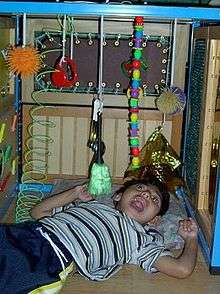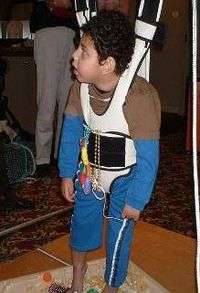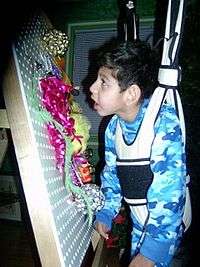Lilli Nielsen
| Lilli Nielsen | |
|---|---|
 | |
| Born |
December 21, 1926 Rønne, Bornholm, Denmark |
| Died |
24 June 2013 Kolding, Denmark |
| Nationality | Danish |
Dr. Lilli Nielsen (née Reker) (b. December 21, 1926, Rønne, Bornholm;[1] † June 24, 2013, Kolding, Denmark) was a Danish psychologist in the field of teaching blind children and those with multiple disabilities. She has written several books on the subject.
She was the second of seven children, four of whom were born blind. When she was seven she was charged with the responsibility of taking care of her blind younger brother.[2]
She was a preschool teacher, then worked in a hospital, became a psychologist, and eventually was hired to teach the blind.[2]
In 1988 she earned a PhD in psychology at the University of Århus.[1]
Lilli Nielsen has worked as special education adviser at Refsnaesskolen, National Institute to Blind and Partially Sighted Children and Youth in Denmark.[3]
She has been awarded the Knight Order of the Dannebrog.[2]
Dr. Lilli Nielsen died on the June 24, 2013, at the public hospital of Kolding after a short period of illness (pneumonia).
"Little Room"
One of her most famous ideas is that of the "little room." This is a box that is laid over a blind or severely disabled child that has toys and other stimuli hanging from it. The child can then explore and play with the toys. Most will vocalize, even for the first time, due to the superior acoustics of the Little Room. As Nielsen wrote: "The purpose of the 'Little Room' is to facilitate blind children's achievement of spatial relations and reaching behaviour, but it can also be of considerable help for sighted low functioning children."[4]
 Child in "Little room" |
 |
"HOPSA-dress"
The HOPSA-dress provides vertical orientation, without the need for weightbearing, to children with multiple disabilities. Items with interesting textures can be placed near the feet for tactile stimulation. Later, the pulley system can be adjusted so that the child can bear weight gradually, at their own pace.
 HOPSA-dress |
 |
References
- 1 2 About Dr. Lilli Nielsen:CV
- 1 2 3 About Dr. Lilli Nielsen
- ↑ An Introduction to Dr. Lilli Nielsen's Active Learning
- ↑ Nielsen, L. (1992). Space and Self. Copenhagen, Denmark: Sikon Press